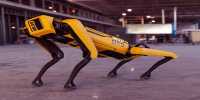A debilitating condition that prevents people from performing many simple daily tasks represents one of the biggest clinical challenges in both managing and treating partial or complete paralysis. In the United States alone, about 5.4 million people now live with some degree of paralysis.
Researchers at the University of Melbourne have shown a technology that allows patients to control computers with just their brains, in a new study published in NeuroInterventional Surgery. Simply in the form of a paperclip, this device enables paralyzed upper limbs to perform an array of previously impossible tasks such as texting, emailing, and web browsing.
ALS, also known as Lou Gehrig’s disease and motor neuron disease, is a progressive disease of the nervous system that gradually affects motor control in the muscles and eventually removes the ability to speak, eat, and breathe. Professor Stephen Hawking was famous for this disease and relied on computer translators for communication which was controlled by the detached cheek twitch. Although it worked well and enabled the prof. Hawking is hopeful that sharing his work directly with the computer will enable patients to perform more of their daily tasks with ease of use. After their recovery, the device was used alongside an eye tracker to perform a number of computer- ased tasks to see how effective the system was. The study described two people with amyotrophic lateral sclerosis (ALS) who underwent surgery to implant the device in their brains.
The device is a small, wireless implant that interferes with the individual’s brain and removes the cursor with an eye tracker, allowing direct control of the computer without the use of hands. To implant the device, a small keyhole incision is made in the neck and the chip is inserted just above the sinus adjacent
to the primary motor cortex.
Despite not being able to move both their hands completely, the device allows both patients to complete online banking, online shopping, and courses for friends and family. Patients then received further training involving machine learning to enhance their available functions – as a result, they could soon use multiple mouse functions such as zooming in. These two patients managed an average click accuracy of 92-93 percent without a predictive text and a typing speed of 14 and 20 characters per minute.
Professor Mitchell said: This is the first time an operation has been performed, so we cannot guarantee that there will be no problems, but in both cases, the surgery has been better than we expected." The director of the Neurointervention Service and chief investigator of the trial, said in a statement.
Associate Professor Thomas Oxley, who is the co-principal, Associate Professor, Thomas Oxley, said, “We’ve delivered fully implants, taking home wireless technology that doesn’t require open brain surgery, and we’re encouraged,” said Vascular Bayon of the University of Melbourne.
The results represent an exciting preliminary report of what can be achieved through this technology, but we are still many years away from a neural interface device reaching the public. Testing is planned across Australia in anticipation of the growing combination to continue analyzing the device’s performance.
















